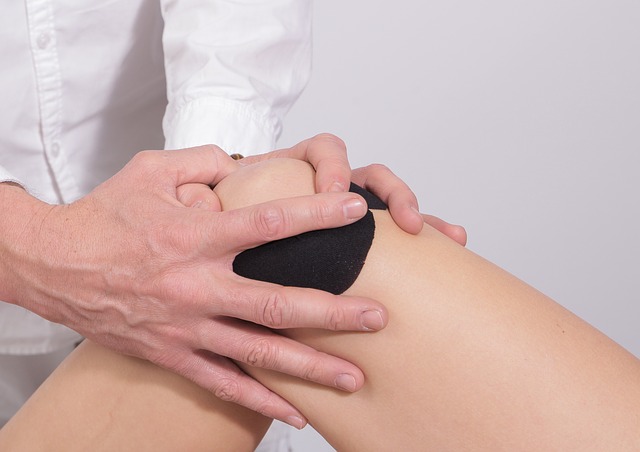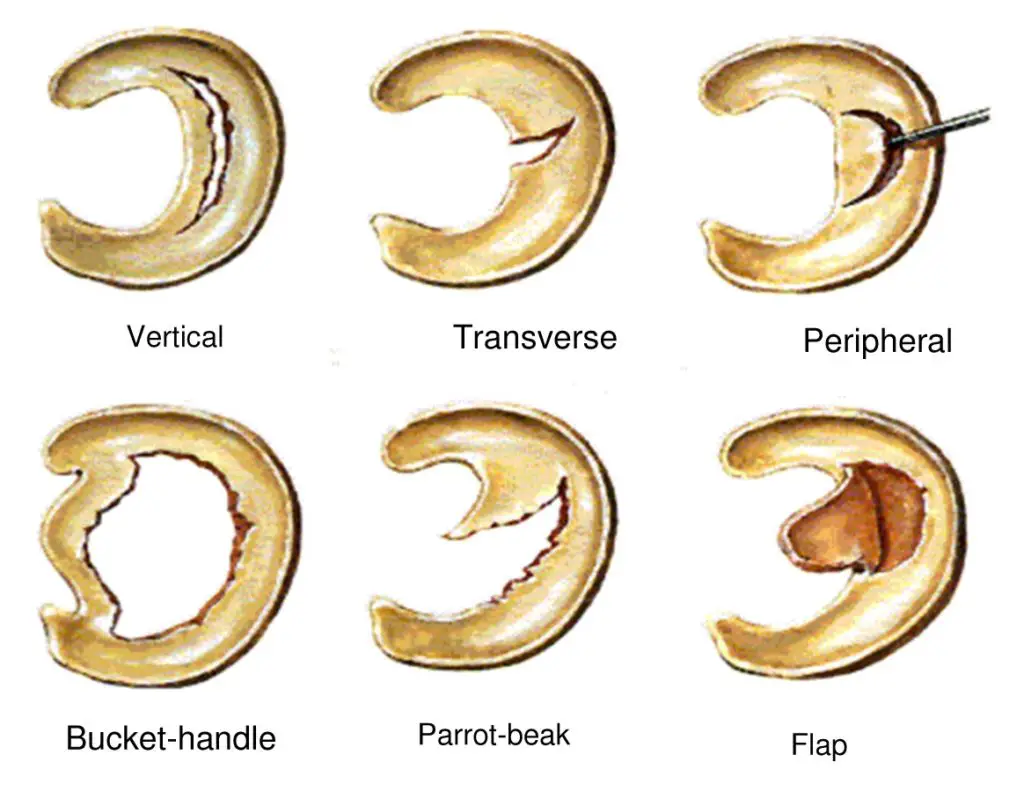The Best Exercises After Meniscus Surgery
Meniscus Surgery is one of the most common knee surgeries in orthopedics today. From 2005 to 2011 the number of meniscus surgeries increased by 100%, that’s a huge amount. One source even quotes the incidence as high as 1 in 300 people with have surgery on their meniscus. Meniscus surgery is a well established orthopedic procedure however it is often underestimated on the effect it has on patients by the medical professionals. Surgeons may not even prescribe formal physical therapy after the procedure because they do so many and the “knee is now back to normal.”
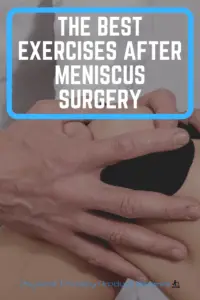
What are the Menisci?
The menisci are two pieces of articular cartilage between the bones of the lower leg. The medial or inside meniscus is “C” shaped while the lateral or outside meniscus is more circular.
The meniscus acts to provide shock absorption and stability at the knee joint. The Menisci are more elastic than most of the cartilage in the body and helps absorb force when we are walking, running, and jumping.
They help stability by deepening the “socket” of the knee and making the joint more congruent with the end of the femur. This deepening of the joint prevents the femur bone from slide too far forward or backward.
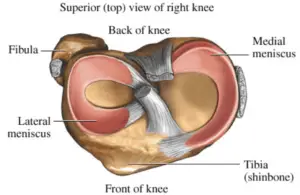
What are the Symptoms of a Meniscus Tear?
Meniscus tears are a common injury in sports and with activity. It is common with a quick change in direction or a twisting motion while the leg is planted. They also occur frequently with other knee injuries such as ACL tears. Common symptoms of a meniscus tear are:
- Popping
- Clicking
- Catching and locking in the knee
- Pain with full squatting and kneeling
- Pain with twisting or running along the joint line
Do I have to have Surgery for a Torn Meniscus?
No, not necessarily. There is a growing body of evidence that physical therapy and conservative treatment may be as or more beneficial than surgery as soon as a year after the initial injury. This is especially true for degenerative meniscus tears which have much less success with surgery. The degenerative tear is the person who is 45-55 years old (or older) and also has a fair amount of arthritis. The increased amount of arthritis makes this type of tears difficult to heal after surgery and may even speed up the degeneration. Sometimes in these situations a knee brace for a meniscus tear is a better option.
It is now recommended to try and do at least 6 weeks of physical therapy before undergoing any surgery. After controlling swelling, increasing range of motion, and progressively increasing your strength it provides a much better picture if surgery is needed.
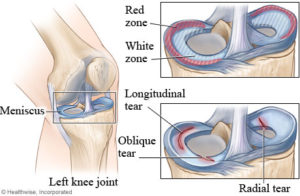 In terms of location for meniscus tears, 25% tear in the outer layer. This area has a good supply and may heal with time and therapeutic exercise. 75% of the tears occur in the inner portion of the meniscus which will likely not “heal” due to the poor blood supply and healing limitation. This does not necessarily mean that the tears occurring on the inner portion have to have surgery as many people have meniscus tears and do not even realize it. Even though it won’t like heal in the inner portion that tear may simply scar down and you might simply forget about it in the long run.
In terms of location for meniscus tears, 25% tear in the outer layer. This area has a good supply and may heal with time and therapeutic exercise. 75% of the tears occur in the inner portion of the meniscus which will likely not “heal” due to the poor blood supply and healing limitation. This does not necessarily mean that the tears occurring on the inner portion have to have surgery as many people have meniscus tears and do not even realize it. Even though it won’t like heal in the inner portion that tear may simply scar down and you might simply forget about it in the long run.
Types of Meniscus Tears
The outcomes and ability to heal depend on many factors including the type of meniscus tear. The primary types of meniscus tears are:
Incomplete Meniscus Tear
This type of tear generally associated with wear and tear. This is often found on most MRIs especially in older patients and is not considered serious. These types of tears often do not need or respond well to surgery.
Radial Meniscus Tear
One of the most common types of tears that often goes from the outside towards the middle of the meniscus. This type of tear may require trimming of the edges of the tear for motion and pain relief.
Longitudinal Tear
Most commonly occurs during athletics and often tears along the outside of the meniscus. This may have the ability to heal if located in the vascular portion of the meniscus.
Bucket Handle Tear
One of the most popular types of tears. This is a horizontal tear that the torn flap has flipped over like a “bucket handle.” When the tear flips this can cause locking of the knee and difficulty with movement. This does most often require surgery to fix the motion block.
Horizontal Meniscus Tear
The horizontal tear is a tear that simply goes through the middle of the meniscus. Depending on the size and location this can develop into a bucket handle tear or may respond to a meniscus repair surgery if in the vascular area.
Complex Tear
This tear is a combination of the different types of tears and is complex in nature. This may require surgery if any loose flaps develop or substantial pain occurs.
photo credit from webmd, and https://lifesworkpt.com/2017/05/what-is-a-torn-meniscus-in-the-knee/
Degenerative vs Traumatic Meniscus Tears
A meniscus tear can also be from a traumatic injury such as twisting during sports or a degenerative which is a tear from general wear and tear.
Degenerative Meniscus Tear
This type of tear occurs over time and is a result of normal forces placed on the knee over a certain time period. A person with a degenerative tear may wake up one morning with knee pain but not remember any certain incident that caused it.
Traumatic Meniscus Tear
This type of tear occurs with a certain trauma or incident and you usually remember the specific time. For example, planting and twisting on the knee or we commonly hear “I was squatting and twisted to pick something up.” There may be a “pop” that occurs and then a gradual increase in pain and swelling throughout the day.
What are the Different Types of Meniscus Surgery?
The two main types of surgeries that occur for a meniscus tear are a Meniscus Repair or a Partial Meniscectomy.
Meniscus Repair
Overview – In a Meniscus repair, the surgeon with go in and try to suture the torn edges of the torn meniscus together. They may also debride or clean up the edges of the tear. The surgeon may even score or rough up the underlying tissue to help with better healing and blood flow to the area. One of the main benefits of this surgery is that it reduces the risk of developing osteoarthritis in the future. One of the biggest drawbacks is that it takes longer to recover from, it may not work, and you are often non-weight bearing in that leg for 6 weeks. The trend is to allow weight-bearing sooner than 6 weeks but this is surgeon dependent. See a surgery video here: Meniscus Repair.
Timeline – Recovery from this surgery is longer and slower. This is because for the first 4-6 weeks the patient is often in a non-weight bearing or partial weight-bearing restriction. This is dependent on the surgeon and a great question to ask.
- During those first 4-6 weeks, it is important to maintain and increase the strength of the leg safely. Preserving and improving muscle mass is important in this state.
- Once you are cleared for full weight-bearing it often takes another 6 weeks of physical therapy and strengthening exercises to you get back to feeling normal and reducing injury risk.
Crutches – If you non-weight bearing for the first 4-6 weeks you will get so tired of using crutches. One of the best alternatives to save your arms and armpits is to use a knee scooter to get around long distances and crutches for short distances.
Partial Meniscectomy
Overview – In a partial meniscectomy surgery, the surgeon will shave, cut, or trim the torn pieces of the meniscus to make the surface smooth and uniform. This debridement allows the joint to move freely. There is a small chance of an increase in the progression of arthritis depending on your age and this overall a faster recovery. Pt’s are usually walking without crutches within a weeks time. See a surgical video here: Partial Meniscectomy.
Timeline – In general 6-12 weeks and you will be back to normal. At the 6 week mark, most people feel better than 80% of normal and don’t notice it much during their daily activities. For high-level sports, there may be pain still present at 6 weeks and may take the full 12 weeks to be able to play pain-free. Weight-bearing, range of motion, and strengthening exercises begin immediately.
Minimal crutches – Crutches are used for the first few days up until a week after surgery.
Common Items Needed After Meniscus Surgery
Ice machine
This one of thest top items on the list for pain control and swelling. The first weeks you will use this many times a day. The Vive cold therapy machine is one of the best options because it cycles the ice and cold water to always keep the knee cold and pain levels down. It’s easy to use and something that you will undoubtedly use again in the future.
Aerobic Step for Strenthening
This simple yet effective piece of equipment is one of the best and safest ways to strengthen the knee after surgery. The step allows for many different types and variations of exercises to be performed at home. See below for exercises that use an aerobic step and our favorite is the simple yet effective KLB Sport 31″ Adjustable Step.
Compression Sleeve
The compression knee sleeve will help with pain and swelling in the early phases of recovery. They are relatively inexpensive and worth the price to help maintain the swelling and provide confidence in the knee. The extra support and warmth will also help speed up the healing process. Our favorite is from Cucial Compression since it comes in a two pack and adds just the right amount of compression.
Crutch Pads
Save the armpits! If you have a meniscus repair you will want to make sure that you have these to add a little cushion to the armpits. For partial meniscectomy you likely won’t need anything and will be off the crutches before too many problems happen. We love these crutch pads for the fun colors, simplicity, and inexpensive cost.
Stretching Strap
This simple yet effective strap helps you get your range of motion faster, and the faster you get your motion back the better. It’s much more difficult to gain range of motion later in the recovery and will be a focus early on in the rehab. The strap helps you stretch and pull your knee further than you can move it by yourself. Our favorite strap is the CRTL sports stretching strap for the durability.
Knee Scooter
This is only if you have a meniscus repair and you need to stay active. If you have to go to work, school and need to walk even moderate distances then consider getting a knee scooter. It will save your armpits, protect your other knee from wearing out, and get you places much faster during your 6 weeks of nonweight bearing.
Disclaimer: This post is for informational purposes only. Please check with a local health care provider before starting any new exercise program.
The Best Exercises After Meniscus Surgery
Disclaimer: These are for informational purposes only. Please consult your physician or health care profession before beginning any exercises after surgery.
Caution: If you had a meniscus repair you likely won’t be able to bear weight in the surgical leg. Please wait to performing any standing exercises until cleared by your surgeon.
Phase 1: 0-2 weeks after Meniscus surgery
Heel Slides
The goal of this exercise is to gain knee ROM and quickly. Heel slides should be performed with a stretching strap and done many times during the day to prevent the knee from stiffening up. You can also perform this exercise on your back with the feel on the wall if you have back problems. as seen here: Wall slides
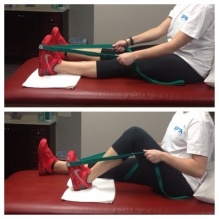
Quad Sets
This exercise is important for 2 reasons, it helps turn your quad muscle back on after surgery and it helps get your knee straight. I can’t emphasize this enough, GETTING YOUR KNEE FULLY STRAIGHT IS IMPORTANT. This exercise is a standard across all knee surgeries and should be done as frequently as possible. See video here: Quad sets with heel prop
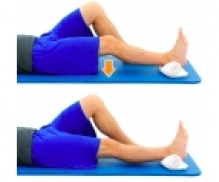
Side-Lying Hip Abduction
Get ready to feel the burn. This is a great exercise to do early in rehab tp the strengthen the hip. This exercise targets the important muscles that help stabilize the hip and maintain the alignment of the leg and helps prevent excessive rotation at the knees. Make sure to keep the leg inline or behind you when performing. See video here: Side lying hip abduction.
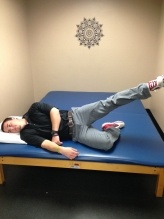
Short Arc Quad
This exercise is to get your quads firing. Find a bolster or a foam roller and place it underneath the knee. Tighten the quad muscles to lift the lower leg straight. It’s important to get the knee all the way straight and try to hold for at least 5 seconds to help the nerves and muscles return to normal. See video here: Short Arc Quad
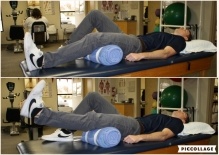
Standing Terminal Knee Extensions
This exercise is perfect to work on knee extension but in a weight bearing position. All you need is a resistance band. Start by standing with your knee bent, tighten your quad and straighten your knee all the way back. Try to hold for at least 5 seconds per rep. See video here: Standing Terminal Knee Extensions
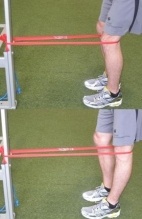
Single Leg Balance
You likely won’t be able to start right away on a single leg balance but is great to start working towards for a faster recovery. Start with equal weight in both legs standing at the counter or kitchen sink and shift to the surgical side. Each time you should start increasing the amount of weight put into the surgical leg until you can do a single leg balance with minimal pain. The goal of this exercise is to get your knee and muscles ready for weight-bearing and single leg stance which is important during walking. See video: Single leg balance
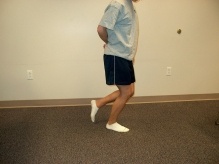
Phase 2: 2-4 weeks after Meniscus surgery
Hamstring Curls on an Exercise Ball
The Hamstring curls on an exercise bike is one of the best ways to strengthen the hamstrings and help with knee flexion range of motion. Start by lying on your back with your feet on top of the exercise ball. Lift your hips up to the ceiling and roll the ball towards your butt. Return to the starting position and repeat at least a few sets of 10. See video: Hamstring culs on Exercise Ball
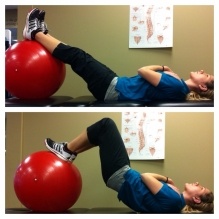
Air Squats
The goal of squats at this time in recovery is you get the joints and muscles ready to go. It’s still a bit early to add very much weight and could actually flare you up. Instead the focus on making sure the weight is equal in both legs and work on getting back to a normal squat depth. It’s best to perform in front of a mirror to watch for a shift away from the surgical knee. See video here: Air Squat
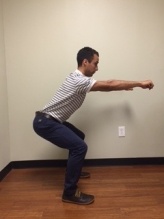
Step-Ups
One of the most underrated exercises during knee rehab. Using a step or a workout step, try to bring yourself up on to the step using the surgical leg. One tip is to avoid pushing off with the nonsurgical leg to vault yourself up. Try to perform slow and controlled, the slower the better to get muscle growth. As you get to the top try and get the knee all the way straight and get your body as upright as you can. See video: Step ups
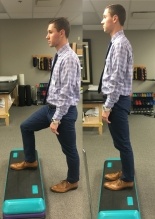
Eccentric Step Downs
This exercise is absolutely one of our favorite exercises overall. You can see out complete review of Eccentric Step Downs here and why we love it. Start by standing on of the step with your surgical leg as the stance leg. Slowly lower your other leg down to the floor and just barely tap the ground but not transfer any weight. Then slowly bring yourself back up. This is the beginnings of single leg squat trainging. This exercise is great to gain rotational control of the leg. See video: Eccentric step down
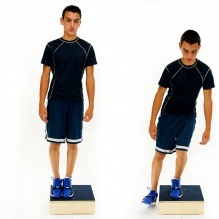
Reverse Lunges
The final exercise that you need to do in phase 2 of rehab and its a good one. This exercise works the entire lower half of the body and really targets the quads, glutes, and hamstrings. We start with a reverse lunge vs a forward lunge because it is less stress and force through the knee joint. Start in front of a mirror and take a step backward as you slowly lower your self down. The front hip and both knees should be in a 90 degree angle and the chest should stay upright. You can focus solely on the surgical leg or alternate. Shoot for at least 30 reps. See video: Reverse Lunge.
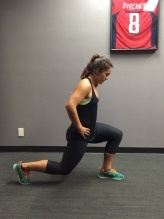
Phase 3: 4-6 weeks after Meniscus surgery
Bulgarian Split Squat
If the eccentric step down is our favorite exercise then this is a close second one. This is a great exercise to isolate and strengthen the surgical leg while working on control and balance. Stand in from of a chair or bench and take a big step with the surgical into a lunge stance. Put your back foot on top of the bench or chair. Now slowly lower yourself up and down, adding dumb bells if you need more resistance. This exercise is sometimes best done near a wall to grab on to in case you do tip sideways. See video: Bulgarian Split Squat.

Eccentric Step Downs
The same exercise as in phase 2 but now you get to add weight! Feel free to hold this exercise at the bottom of the movement or add dumbbells to make it harder.
This exercise is absolutely one of our favorite exercises overall. You can see out complete review of Eccentric Step Downs here and why we love it. Start by standing on of the step with your surgical leg as the stance leg. Slowly lower your other leg down to the floor and just barely tap the ground but not transfer any weight. Then slowly bring yourself back up. This is the beginnings of single leg squat trainging. This exercise is great to gain rotational control of the leg. See video: Eccentric step down

Bulgarian Split Squat
If the eccentric step down is our favorite exercise then this is a close second one. This is a great exercise to isolate and strengthen the surgical leg while working on control and balance. Stand in from of a chair or bench and take a big step with the surgical into a lunge stance. Put your back foot on top of the bench or chair. Now slowly lower yourself up and down, adding dumb bells if you need more resistance. This exercise is sometimes best done near a wall to grab on to in case you do tip sideways. See video: Bulgarian Split Squat.

Forward Lunges
Since you have done the reverse lunges in phase 2, now it’s time for forward lunges. Start slow and slowy add weight as you feel appropriate as this cause the knee to be sore the first few rounds. Make sure that the knee does not progress past the toes on the front leg and go as deep as you feel comfortable. See video: Forward Lunges

Goblet Squats
One of the best squat variations, the goblet squat exercise targets the core and legs while adding resistance to improve strength. Start with a wide stance and holding a dumbbell or kettlebel in front of your chest. Squat down as deep as the knee will tolerate and hold for 2-3 seconds. Slowly increase the depth each day that you do them to improve loaded knee rom. See video here: Goblet squats.
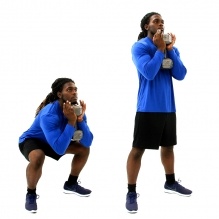
Phase 4: 6+ weeks after Meniscus surgery – return to normal activities
At or around 6 weeks after surgery, you will likely have a follow up with your surgeon. At this point, they will likely clear you for all activity and you won’t have to see them again. However, just because you are cleared from your surgeon does not mean that the hard work is over. It still can take months for the strength to come back to prior levels before surgery. Until that time, you are at an increased risk for injury due to the limitations in strength. A few tips as your get back to normal:
- As you return to running start slow and progress 10-15% each week to avoid injury
- Don’t start running or jumping until you can hold a single leg squat for 30 seconds
- Warm up properly before returning to any sporting activity
- Continue to strengthen the leg, it is one the thing that has been shown to decrease injury risk
Disclaimer: The information provided in this post is for educational purposes only. This is not a substitute for a medical appointment. Please refer to your physician before starting any exercise program.
